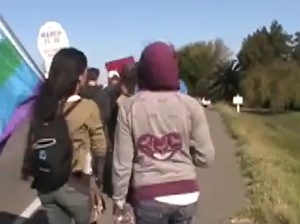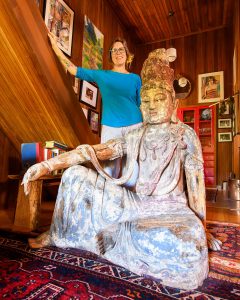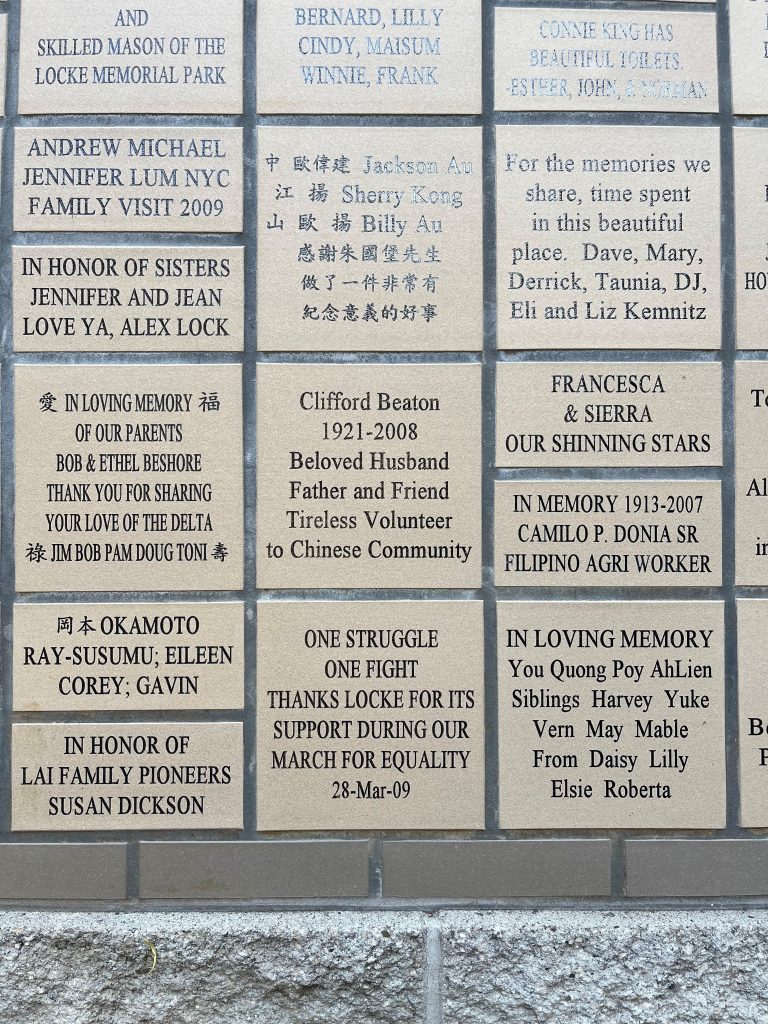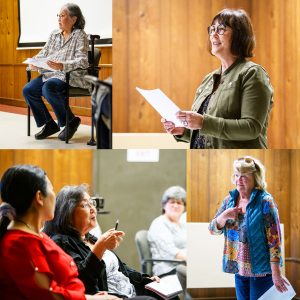
Video screenshot of One Struggle One Fight marchers as they left Locke in March 2009
Gay activism in California is often associated with cities. But in March 2009, a group of activists took their cause on a march through the rural Sacramento-San Joaquin Delta – not a region known for protest marches or gay activism.
The trek was a five-day walk from San Francisco to Sacramento to call for the repeal of Proposition 8, the gay marriage ban that California voters added to the state Constitution in 2008. Organized by One Struggle One Fight, the march went through Walnut Creek, Antioch, Isleton, Locke, and Elk Grove before finishing at the steps of the state Capitol.
Three of the Delta’s five main counties voted in favor of Prop 8, so it might not have looked like sympathetic territory. But march co-leader Seth Fowler said that was part of the point.
“One Struggle One Fight was about direct action and talking to people. There was a really big urban/rural divide, and the question was, ‘How do we make queer people real to people who are mostly just interacting with headlines about us?’”
One answer: by walking through their towns.
He said there were times on the march when he could sense discomfort among people they interacted with.
But there were also many warm welcomes. What the 30 or so marchers were doing “is such important work” the Rev. Christy Parks-Ramage told them when they gathered at the First Congregational Church of Antioch. “And it’s work that we as a congregation have struggled with.”
The church had recently become “open and affirming,” officially welcoming LGBT people in its ministry. The decision caused a split, and so many congregants had left that the church was selling its building to forge a new path.
The marchers also found welcome in the tiny town of Locke, with a population hovering around 70. Locke was built by Chinese immigrants in 1915, two years after the state passed a law forbidding land ownership or long-term leases by non-citizens, so they couldn’t own the land they built on. (So-called Alien Land Laws were invalidated by the California Supreme Court in 1952.)
In an email to fellow organizers, Fowler described his advance visit to Locke, where he met with the Locke Foundation and discussed the march going through the town. “They were receptive and excited at the prospects of becoming the Gayest Town in America, if only for an evening,” he wrote.

The wooden statue of Guanyin, bodhisattva of compassion, now lives in the Locke home of Deborah Mendel and Russell Ooms (not pictured).
When marchers spent the night in Locke, they stayed in a former Baptist church. “There was a really large wooden statue there of Guanyin, the bodhisattva of compassion,” Fowler recalled. “It felt like a very lovely synchronicity to have this being of compassion watch over us as we slept there.”
He reveres Guanyin to this day.
Russell Ooms, who owned the church building at the time, said the group was delightful. “Locke is a quiet town, and suddenly it was filled with energy,” he said. “It was exciting. They were exciting.”
The marchers left behind a gift for the town: a donation to the Locke Foundation, commemorated in a tile that now lives at the Locke Memorial Park. And at least one of the townspeople – Stuart Walthall – joined them at the march’s finale: a rally at the Capitol.
The marchers ultimately got their wish about Proposition 8: It was overturned by the U.S. Supreme Court in 2013. And public opinion in California about gay marriage changed even faster, going from majority opposition in early 2009 to majority support in early 2010.
This year, on Nov. 5, California voters will decide whether to remove Prop 8 language from the state Constitution.
Videos from the march:

The marchers made a donation to the Locke Foundation during their stay, commemorated with this tile. (Photo ©Deborah Mendel, used with permission)
 The Delta’s history is deeply intertwined with the story of Chinese, Japanese, Filipino, and Sikh immigration to California. Drawn first by the Gold Rush and then by railroad construction, Asian immigrants fanned out across the Delta as farming ramped up. They built Delta levees, worked on farms, and even leased or bought their own farms … until the state forbade it for some nationalities.
The Delta’s history is deeply intertwined with the story of Chinese, Japanese, Filipino, and Sikh immigration to California. Drawn first by the Gold Rush and then by railroad construction, Asian immigrants fanned out across the Delta as farming ramped up. They built Delta levees, worked on farms, and even leased or bought their own farms … until the state forbade it for some nationalities.
The Asian presence in the Delta remains vividly on display in the towns of Isleton and Walnut Grove, which have distinct China- or Japantowns, and Locke, which was an entirely Chinese-American town until recent decades.
And the stories of Asian Americans and Pacific Islanders in the Delta are actively being told. Here are six recent examples:
One
A piece of Locke’s history was recognized Saturday when E Clampus Vitus dedicated a plaque honoring the Bok Bok Man – the traditional Chinese night watchman who patrolled the town after dark, hitting a gong or hollowed wood block on the hour.
Two
Isleton is commemorating its Chinese and Japanese heritage with the construction of a new Asian American Heritage Park, a story detailed recently in Soundings Journal.
Three
The Delta’s Japanese presence took a huge hit when the U.S. sent Japanese-Americans to incarceration camps during World War II. Many dispersed after they were released, never to be heard from in the Delta again. But one such family – the founders of the Locke Boarding House – recently surfaced, and Stuart Walthall shares the story here.
Four
The Delta’s Filipino community made big news last December when a collection of home movies from the 1950s to the 1970s shot by the Bohulano family in Stockton was one of 25 films added to the Library of Congress’s National Film Registry. The snapshot of Filipino family life and immigrant experience joined the registry alongside films including Apollo 13, Fame, Home Alone, Terminator 2, The Nightmare Before Christmas, and 12 Years a Slave.
Five
The Sikh presence in the Delta – Stockton was the home of the first Sikh temple in the United States – has been documented recently by Lea Terhune in the book, “California’s Pioneering Punjabis: An American Story” (The History Press, 2023).
Six
The National Parks Conservation Association on Wednesday highlighted the need to preserve America’s historic Chinatowns, and in the same post shone a spotlight on seven urban and rural sites already on the registered landmarks and historic places lists. Both Locke and Walnut Grove made the list.

WALNUT GROVE, Calif. (March 20, 2024) – The role women have played in Delta history has been somewhat invisible, said Maryellen Burns, president of the Sacramento River Delta Historical Society: “They’re the ones who did the interviews, they’re the ones who transcribed them, but the people they interviewed were men.”
The Society took steps to remedy that Tuesday with its program, “Hidden Figures – Women of the Delta,” at the Walnut Grove Library. The program highlighted four historical figures using the Readers Theater Method, with modern women acting out their roles.
Jean Harvie: The woman for whom Walnut Grove’s Community Center was named helped teach three generations of students in the town as a teacher, then principal, then superintendent. She was a woman of small stature, poor eyesight and little tolerance for tomfoolery. Harvie was played Tuesday by community leader Linda Van Loben Sels – lower right in photo above – whose father earned Harvie’s wrath by hotwiring her car one day and going for a joy ride.
Charmian London: Charmian London and her better-known husband and novelist Jack spent two months every year in the Delta – an experience that shaped his writing, and her substantial contributions to his work. Her eloquent recollections of that time included a passage about her and Jack contemplating going aboard a “red light” boat docked next to them, but thinking better of it as they considered being seen there, or seeing others who might not wish to be seen. London was played by Delta Mello, executive director of the Sacramento History Museum, upper right in photo above.
Aoifee McCarthy: McCarthy was a copywriter in the 1930s and 1940s whose work saturates the labels and advertisements of fruit and meat packers of the region. An immigrant from Ireland, she had intended to settle in New York with her brother, but he sent her to California, where a transcendent slice of peach pie on the train journey lit up her imagination. “I had never eaten a peach,” she wrote. “Those peaches came from seeds that John Sutter himself planted,” the chef told her before sharing the recipe for the pie. McCarthy was played by Burns, who has copies of that very recipe – which she’ll share on request.
Connie King: King was the informal “Mayor” of Locke who fought both to preserve the historic town, and to buy the land on which the town was built – something that was originally made impossible by the Alien Land Law, which prohibited Japanese, Chinese, Koreans, Filipinos, and other East Asians from owning land or leasing land for more than three years. King was also known for her famous “Toilet Garden,” made of toilets that were being thrown away by a new property owner. When she asked him why he was getting rid of them, he told her, “We don’t want to sit on a toilet Chinese people sat on.” King was played by Cynthia Lee, a retired teacher, upper left in photo above.





 The Delta’s history is deeply intertwined with the story of Chinese, Japanese, Filipino, and Sikh immigration to California. Drawn first by the Gold Rush and then by railroad construction, Asian immigrants fanned out across the Delta as farming ramped up. They built Delta levees, worked on farms, and even leased or bought their own farms … until the state forbade it for some nationalities.
The Delta’s history is deeply intertwined with the story of Chinese, Japanese, Filipino, and Sikh immigration to California. Drawn first by the Gold Rush and then by railroad construction, Asian immigrants fanned out across the Delta as farming ramped up. They built Delta levees, worked on farms, and even leased or bought their own farms … until the state forbade it for some nationalities.